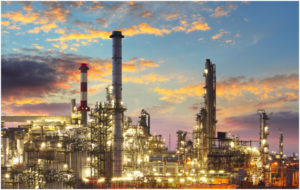1. Direct measurement of catalyst concentration and mass flow
In the production of polymer resins, instantaneous and average catalyst mass flow is essential for reaction rate control and high quality production. The Correflow MFM provides direct measurement of catalyst concentration and mass flow, allowing closed-loop process control from this important parameter. Other instruments measure only the mass flow of the slurry, not the catalyst fraction, and erroneously assume that the slurry concentration is always constant.
The MFM is the only in-line, real-time system to measure velocity, concentration, and mass flow of each component in various two-phase mixtures. The system measures gas, solid, or non-conducting liquid in nearly any combination of two materials (this includes gas in insulating liquids, solids in insulating liquids, solids in gas, and miscible insulating liquids). In many process streams, the MFM is the only way to accurately monitor actual feed rates.
Maintaining maximum reactor productivity is only one of the concerns addressed by the modem-equipped Correflow MFM unit. The rate at which catalyst is delivered to a reaction is also critical in achieving desired mechanical properties. The MFM System also provides early warning for abnormal operation such as clogged feed lines and empty feed pots. Due to the residence time of the catalyst, controllers without the MFM would not have real-time feedback and would have to wait until the reaction slowed before realizing that there was a problem. The Correflow MFM enables closed-loop process control to automatically monitor and adjust catalyst flow for maximum reactor efficiency.
Benefits
- Improves reaction control, quality and consistency
- Reduces the production of off-spec material
- Detects feed line clogging instantaneously
- Detects feed supply concentration changes instantaneously
Even before the polyethylene (PE) reaction, manufacturers clearly need to be sure that high purity feed stocks are available and advanced catalyst systems are chosen to result in efficient chemical reactions. Equally important is the ability to monitor and control the feeding of these constituents to a degree that enables optimum reaction performance. In particular, the direct determination of the catalyst mass flow as it is feed into the reactor is one of the most critical parameters of a PE reaction. Yet given this critical importance, it is surprising that many PE manufacturing plants still do not have any direct means of catalyst mass flow monitoring.
Poor control of a catalyst feed will significantly impact production capacity and product quality. In addition, unexpected variations in catalyst feed can wreak havoc on process control and polymer properties. Given the difficult nature of feeding catalyst in a multi-phase flow (solid in liquid or solid in gas), it is no wonder that this is a common problem area in most PE reaction processes.
Correflow MFM® (Mass Flow Monitor) is designed specifically for the determination of catalyst flow monitoring in polyolefin processes. The MFM is well suited for implementation in-line in the catalyst feed system. With custom-built sensors, the MFM does not introduce any obstruction or additional pressure drop in the catalyst feed line. In addition, the non-contact analysis uses no moving parts so it is a proven reliable technique for catalyst mass flow monitoring.
A catalyst feeder system may occasionally operate with less efficiency than expected. This can be caused by a range of problems such as clogging, leaking, or valve sticking and will have adverse effects on productivity and create difficulty for operators trying to maintain tight PE quality specifications.
2. General Mass Flow Monitoring Solutions
On-line mass flow measurement of particulate solids in emission stacks and pneumatic pipelines plays a crucial role in achieving increased productivity, improved product quality, reduced particulate emissions and higher process efficiency. However, the measurement and monitoring of particles in a gas stream has been a technical challenge for anyone involved in the subject area. Electrostatic and capacitive particulate matter sensing technology is proven to be the most reliable and cost effective, and sometime the only practical method, to measure particulate solids flow in these industrial operations.
